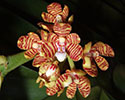
Traditional phytotheraphic record of orchids of Odisha and their conservation strategies
Abstract
Odisha being the coastal state of Indian sub-continent records a rich medicinal plant diversity in general and orchids in particular. Since time immemorial, these important plant resources remains in a neglected state leading to an alarming situation in near future. Virgin forests of Odisha spreading in areas like Gandhamardan Hills, Niyamagiri Hills, Deomali Hills, Mahendragiri Hills and Similipal Biosphere Reserve hoards rich orchid diversity enduring luxuriant growth. Out of 137 species of Orchids recorded so far, Similipal area alone harbours about 94 orchid species possessing high aesthetic and medicinal value. Unfortunately, the medicinal importance of orchids of this region has drawn least attention from both the scientific fraternity as well as general populace compared to their role in horticulture field. Orchid species of Odisha like Acampe carinata (Griff.) Panig., A. praemorsa (Roxb.) Blatt. & Mc Cann, Geodorum recurvum (Roxb.) Alston, Habenaria marginata Coleb., Rhynchostylis retusa (L.) Bl. and Vanda testacea (Lindl.) Rchb.f. are used to cure rheumatism, arthritis, dysentery, asthma and snake bite etc. However, the medicinal potentialities of these orchids are not so well exploited though they possess immense curative values. Further, as the forests of Odisha are experiencing various anthropogenic as well as abiotic pressures, many of the orchid populations are fast shrinking leading to their mass depletion. Realizing this, the current communication highlights the importance of 26 medicinal orchids very often used by the tribal populace of Odisha like Bonda, Dongaria Kondha, Juang, Saora etc. to get relief from various ailments. Concurrently, some major conservational strategies have also been projected.
Keywords
Full Text:
PDFReferences
Y. S. Agarwal and B. Ghosh. Drug plants of India (Root Drugs), Kalyani Publishers, New Delhi (1985).
R. N. Chopra, S. L. Nayar and I. C. Chopra. Glossary of Indian Medicinal Plants, CSIR, New Delhi (1956).
H. H. Haines. The Botany of Bihar and Orissa, 6 parts, London (1921-25).
K. R. Kirtikar and B. D. Basu. Indian Medicinal Plants.Vol (1-2), ICMR, New Delhi (1935).
S. Misra.Orchids of Orissa.Mahendra Singh Bishen Pal Singh, Dehra Dun (2004).
M. P. Nayar and A. R. K. Sastry. Red Data Books of Indian Plants, vol. 1-3. Botanical Survey of India, Howrah (1987).
S. P. Panda and S. Misra. Medicinal orchids of Orissa and its conservation. In: Souv. Nat. Sem. on Common medicinal plants and their use held at Banki Autonomous College, Banki, Cuttack, 6th January (2008): 52-55.
A. K. Sahoo. Plant Resources of Kandhamal district (Orissa): some suggestion to develop cottage industries in tribal localities, Orissa Review 43. 4 (1986): 39-44.
H. O. Saxena and M. Brahmam.The flora of Orissa, Vol. (1-4). Odisha Forest Development Corporation, Bhubaneswar (1994-96).
H. O. Saxena and P. K. Dutta. Studies on the ethnobotany of Orissa. Bull. Bot. Surv. India 17. 1-4 (1975): 124-131.
G. V. Stayavati, A. K. Gupta and N. Tandon. Medicinal Plants of India, Vol. (1-2), ICMR, New Delhi (1987).
H. N. Subudhi and B. P. Choudhury. Ethnobotanical studies in the district of Kandhamal (Odisha-1), Bio-Sci. Res. Bull. 1. 1-2 (1985): 26-32.
P. K. Warrier, V. P. K. Nambiar and C. Ramankutty. Indian Medicinal Plants, (Vol.1-5), Orient Langman Ltd., Madras (1994-96).
Copyright (c) 2015 Annals of Plant Sciences

This work is licensed under a Creative Commons Attribution-NonCommercial-NoDerivatives 4.0 International License.


